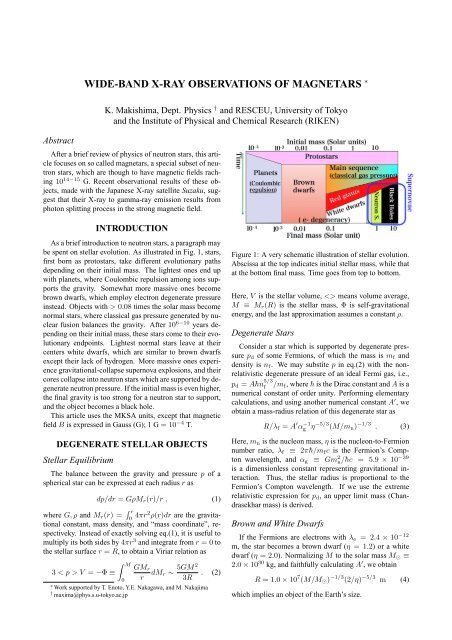Proceedings of International Conference on Physics in ... - KEK
Proceedings of International Conference on Physics in ... - KEK
Proceedings of International Conference on Physics in ... - KEK
Create successful ePaper yourself
Turn your PDF publications into a flip-book with our unique Google optimized e-Paper software.
Abstract<br />
WIDE-BAND X-RAY OBSERVATIONS OF MAGNETARS ∗<br />
K. Makishima, Dept. <strong>Physics</strong> † and RESCEU, University <str<strong>on</strong>g>of</str<strong>on</strong>g> Tokyo<br />
and the Institute <str<strong>on</strong>g>of</str<strong>on</strong>g> Physical and Chemical Research (RIKEN)<br />
After a brief review <str<strong>on</strong>g>of</str<strong>on</strong>g> physics <str<strong>on</strong>g>of</str<strong>on</strong>g> neutr<strong>on</strong> stars, this article<br />
focuses <strong>on</strong> so called magnetars, a special subset <str<strong>on</strong>g>of</str<strong>on</strong>g> neutr<strong>on</strong><br />
stars, which are though to have magnetic fields rach<strong>in</strong>g<br />
10 14−15 G. Recent observati<strong>on</strong>al results <str<strong>on</strong>g>of</str<strong>on</strong>g> these objects,<br />
made with the Japanese X-ray satellite Suzaku, suggest<br />
that their X-ray to gamma-ray emissi<strong>on</strong> results from<br />
phot<strong>on</strong> splitt<strong>in</strong>g process <strong>in</strong> the str<strong>on</strong>g magnetic field.<br />
INTRODUCTION<br />
As a brief <strong>in</strong>troducti<strong>on</strong> to neutr<strong>on</strong> stars, a paragraph may<br />
be spent <strong>on</strong> stellar evoluti<strong>on</strong>. As illustrated <strong>in</strong> Fig. 1, stars,<br />
first born as protostars, take different evoluti<strong>on</strong>ary paths<br />
depend<strong>in</strong>g <strong>on</strong> their <strong>in</strong>itial mass. The lightest <strong>on</strong>es end up<br />
with planets, where Coulombic repulsi<strong>on</strong> am<strong>on</strong>g i<strong>on</strong>s supports<br />
the gravity. Somewhat more massive <strong>on</strong>es become<br />
brown dwarfs, which employ electr<strong>on</strong> degenerate pressure<br />
<strong>in</strong>stead. Objects with > 0.08 times the solar mass become<br />
normal stars, where classical gas pressure generated by nuclear<br />
fusi<strong>on</strong> balances the gravity. After 10 6−10 years depend<strong>in</strong>g<br />
<strong>on</strong> their <strong>in</strong>itial mass, these stars come to their evoluti<strong>on</strong>ary<br />
endpo<strong>in</strong>ts. Lightest normal stars leave at their<br />
centers white dwarfs, which are similar to brown dwarfs<br />
except their lack <str<strong>on</strong>g>of</str<strong>on</strong>g> hydrogen. More massive <strong>on</strong>es experience<br />
gravitati<strong>on</strong>al-collapse supernova explosi<strong>on</strong>s, and their<br />
cores collapse <strong>in</strong>to neutr<strong>on</strong> stars which are supported by degenerate<br />
neutr<strong>on</strong> pressure. If the <strong>in</strong>itial mass is even higher,<br />
the f<strong>in</strong>al gravity is too str<strong>on</strong>g for a neutr<strong>on</strong> star to support,<br />
and the object becomes a black hole.<br />
This article uses the MKSA units, except that magnetic<br />
field B is expressed <strong>in</strong> Gauss (G); 1 G = 10 −4 T.<br />
DEGENERATE STELLAR OBJECTS<br />
Stellar Equilibrium<br />
The balance between the gravity and pressure p <str<strong>on</strong>g>of</str<strong>on</strong>g> a<br />
spherical star can be expressed at each radius r as<br />
dp/dr = GρMr(r)/r , (1)<br />
where G, ρ and Mr(r) = ∫ r<br />
0 4πr2 ρ(r)dr are the gravitati<strong>on</strong>al<br />
c<strong>on</strong>stant, mass density, and “mass coord<strong>in</strong>ate”, respectiveky.<br />
Instead <str<strong>on</strong>g>of</str<strong>on</strong>g> exactly solv<strong>in</strong>g eq.(1), it is useful to<br />
multiply its both sides by 4πr 3 and <strong>in</strong>tegrate from r = 0 to<br />
the stellar surface r = R, to obta<strong>in</strong> a Viriar relati<strong>on</strong> as<br />
3 < p > V = −Φ ≡<br />
∫ M<br />
0<br />
GMr<br />
r dMr<br />
2 5GM<br />
∼ . (2)<br />
3R<br />
∗ Work supported by T. Enoto, Y.E. Nakagawa, and M. Nakajima<br />
† maxima@phys.s.u-tokyo.ac.jp<br />
Figure 1: A very schematic illustrati<strong>on</strong> <str<strong>on</strong>g>of</str<strong>on</strong>g> stellar evoluti<strong>on</strong>.<br />
Abscissa at the top <strong>in</strong>dicates <strong>in</strong>itial stellar mass, while that<br />
at the bottom f<strong>in</strong>al mass. Time goes from top to bottom.<br />
Here, V is the stellar volume, means volume average,<br />
M ≡ Mr(R) is the stellar mass, Φ is self-gravitati<strong>on</strong>al<br />
energy, and the last approximati<strong>on</strong> assumes a c<strong>on</strong>stant ρ.<br />
Degenerate Stars<br />
C<strong>on</strong>sider a star which is supported by degenerate pressure<br />
pd <str<strong>on</strong>g>of</str<strong>on</strong>g> some Fermi<strong>on</strong>s, <str<strong>on</strong>g>of</str<strong>on</strong>g> which the mass is mf and<br />
density is nf. We may substite p <strong>in</strong> eq.(2) with the n<strong>on</strong>relativistic<br />
degenerate pressure <str<strong>on</strong>g>of</str<strong>on</strong>g> an ideal Fermi gas, i.e.,<br />
pd = A¯hn 5/3<br />
f /mf, where ¯h is the Dirac c<strong>on</strong>stant and A is a<br />
numerical c<strong>on</strong>stant <str<strong>on</strong>g>of</str<strong>on</strong>g> order unity. Perform<strong>in</strong>g elementary<br />
calculati<strong>on</strong>s, and us<strong>in</strong>g another numerical c<strong>on</strong>stant A ′ , we<br />
obta<strong>in</strong> a mass-radius relati<strong>on</strong> <str<strong>on</strong>g>of</str<strong>on</strong>g> this degenerate star as<br />
R/λf = A ′ α −1<br />
g η −5/3 (M/mn) −1/3 . (3)<br />
Here, mn is the nucle<strong>on</strong> mass, η is the nucle<strong>on</strong>-to-Fermi<strong>on</strong><br />
number ratio, λf ≡ 2π¯h/mfc is the Fermi<strong>on</strong>’s Compt<strong>on</strong><br />
wavelength, and αg ≡ Gm 2 n/¯hc = 5.9 × 10 −39<br />
is a dimensi<strong>on</strong>less c<strong>on</strong>stant represent<strong>in</strong>g gravitati<strong>on</strong>al <strong>in</strong>teracti<strong>on</strong>.<br />
Thus, the stellar radius is proporti<strong>on</strong>al to the<br />
Fermi<strong>on</strong>’s Compt<strong>on</strong> wavelength. If we use the extreme<br />
relativistic expressi<strong>on</strong> for pd, an upper limit mass (Chandrasekhar<br />
mass) is derived.<br />
Brown and White Dwarfs<br />
If the Fermi<strong>on</strong>s are electr<strong>on</strong>s with λe = 2.4 × 10 −12<br />
m, the star becomes a brown dwarf (η = 1.2) or a white<br />
dwarf (η = 2.0). Normaliz<strong>in</strong>g M to the solar mass M⊙ ≡<br />
2.0 × 10 30 kg, and faithfully calculat<strong>in</strong>g A ′ , we obta<strong>in</strong><br />
R = 1.0 × 10 7 (M/M⊙) −1/3 (2/η) −5/3 m (4)<br />
which implies an object <str<strong>on</strong>g>of</str<strong>on</strong>g> the Earth’s size.













